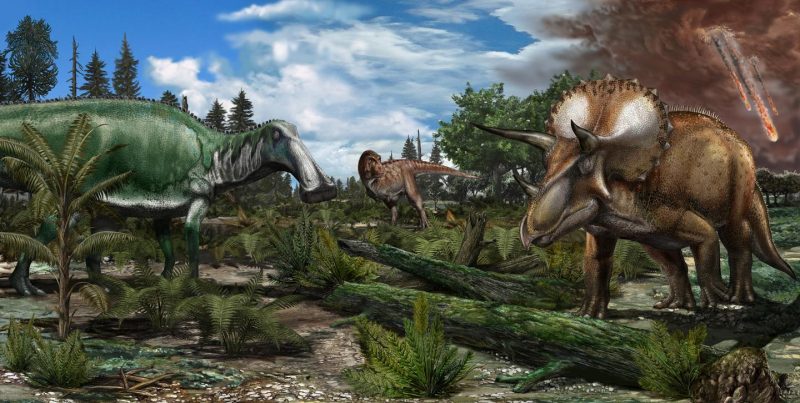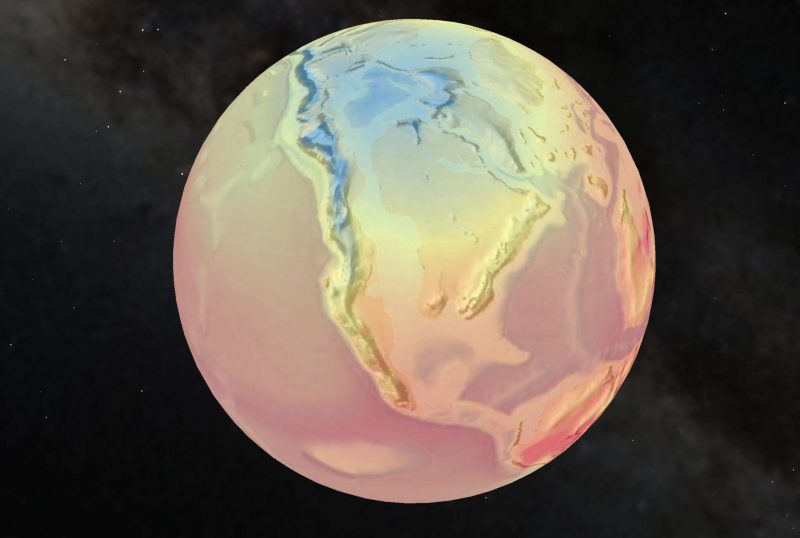Skip to comments.
Dinosaurs thrived before fatal asteroid impact
earthSky ^
| 12MAR19
| By Paul Scott Anderson
Posted on 03/13/2019 4:47:46 AM PDT by vannrox
Scientists have debated whether the dinosaurs were already in decline before a massive asteroid impact finished them off 66 million years ago. New research shows they were thriving in their final days.
Help EarthSky keep going! Please donate what you can to our annual crowd-funding campaign.
Dinosaurs once reigned on Earth, until a cataclysmic event – now thought to have been a massive asteroid impact, or possibly intense volcanic activity – wiped them out about 66 million years ago during the Maastrichtian age at the end the Late Cretaceous epoch. This mass extinction event was sudden and brutal, powerful enough to wipe out the largest creatures to ever walk on the Earth – and countless others as well.
There has, however, been some debate as to what was happening before the mass extinction. Some scientists thought the dinosaurs were flourishing right up until their demise, while others suggested that they had already been in decline before they were finished off.
So which scenario is correct? A new study by researchers from Imperial College London, University College London and University of Bristol shows that it was the former.

Illustration of a late Maastrichtian palaeoenvironment in North America, where dinosaurs like Tyrannosaurus rex, Edmontosaurus and Triceratops roamed the floodplains 66 million years ago. The Maastrichtian was the latest age of the Late Cretaceous epoch. Image via Davide Bonadonna.
The new peer-reviewed paper was published in Nature Communications on March 6, 2019. Alessandro Chiarenza is a Ph.D. student in the Department of Earth Science and Engineering at Imperial and lead author of the study. Chiarenza said in a statement:
Dinosaurs were likely not doomed to extinction until the end of the Cretaceous, when the asteroid hit, declaring the end of their reign and leaving the planet to animals like mammals, lizards and a minor group of surviving dinosaurs: birds.
The results of our study suggest that dinosaurs as a whole were adaptable animals, capable of coping with the environmental changes and climatic fluctuations that happened during the last few million years of the Late Cretaceous. Climate change over prolonged time scales did not cause a long-term decline of dinosaurs through the last stages of this period.
According to the researchers, previous studies had underestimated the number of living species at the end of the Cretaceous period – when the asteroid hit – due to changing fossilization conditions. This led to the erroneous conclusion that some species had already been in decline or gone extinct before the asteroid collision.
The study focused on North America, where some of the most well-known dinosaurs used to roam, such as Tyrannosaurus rex and Triceratops.

A massive asteroid impact – or possible intense volcanic activity – caused the extinction of the dinosaurs 66 million years ago, according to current research. Image via James Thew/iStockphoto.
Way back then, North America was split into two halves by an inland sea. The Rocky Mountains in the western half were forming at this time, and sediment from the mountains created ideal conditions for preserving dinosaur bones. Conditions in the eastern half were far less conducive to preservation, however. Fossils in the western half, along with some mathematical predictions, had been used to suggest that dinosaur populations were in decline before the asteroid hit. Paper co-author Philip Mannion, from University College London, explained:
Most of what we know about Late Cretaceous North American dinosaurs comes from an area smaller than one-third of the present-day continent, and yet we know that dinosaurs roamed all across North America, from Alaska to New Jersey and down to Mexico.
The researchers used a method called ecological niche modelling – or species distribution modelling – that takes into account different environmental conditions, such as temperature and rainfall, which each species needs to survive. When they mapped these conditions, both across the continent and over time, they were able to determine where different dinosaur species could most easily survive changing conditions – before the asteroid impact occurred.
Instead of being in decline, they found that many species were actually more widespread than previously thought. Those species, however, were in locations where fossils were less likely to be preserved and those locations were smaller than initially estimated. The lesser numbers of fossils in these areas had previously led scientists to the conclusion that those species were already in decline, when they actually were not. According to the researchers:
The results of our study suggest that dinosaurs as a whole were adaptable animals, capable of coping with the environmental changes and climatic fluctuations that happened during the last few million years of the Late Cretaceous. Climate change over prolonged time scales did not cause a long-term decline of dinosaurs through the last stages of this period.
Bottom line: These findings make this tale all the more tragic – dinosaurs were thriving at their peak on this planet in the Late Cretaceous. They had taken over the world, and survived other potential calamities, only to have a random chunk of rock from space – or unprecedented volcanic eruptions – seal their ultimate fate.
Source: Ecological niche modelling does not support climatically-driven dinosaur diversity decline before the Cretaceous/Paleogene mass extinction
Via Imperial College London
TOPICS: Astronomy; Education; History; Pets/Animals; Science
KEYWORDS: astronomy; catastrophism; death; dinosaur; dinosaurs; dinosonark; godsgravesglyphs; history; life; noah; paleontology; science; trexonark
Navigation: use the links below to view more comments.
first previous 1-20, 21-38 last
To: Monkey Face
They always scurry away under cover when a bright light starts. ;^)
21
posted on
03/13/2019 9:14:06 AM PDT
by
SunkenCiv
(this tagline space is now available)
To: Red Badger
Socialism results from the spectre of blood in the streets. Back then, they didn't even *have* streets.
22
posted on
03/13/2019 9:16:03 AM PDT
by
SunkenCiv
(this tagline space is now available)
To: JimRed
Doesn’t God say in Genesis, “Let us take this matter unorganized...”? I haven’t read the Old Testament in a year, and I’ve slept since then, so I forget.
That tells me that not everything was put together in its pristine form at the same time.
23
posted on
03/13/2019 9:34:50 AM PDT
by
Monkey Face
(The emptier the wagon is the greater the noise it makes.)
To: SunkenCiv
But, but...
I know: A fool can ask more questions than a wise man can answer.
‘Face
;o]
24
posted on
03/13/2019 9:37:34 AM PDT
by
Monkey Face
(The emptier the wagon is the greater the noise it makes.)
To: Monkey Face
The trick is, if ya don't know, make up a plausible lie. ;^)
25
posted on
03/13/2019 11:59:59 AM PDT
by
SunkenCiv
(this tagline space is now available)
To: pepsionice
“Not to complicate things, but there are at least five massive meteor strikes which play major roles in floods (plural). The last that we can be fairly sure of....was around 12,900 years ago.”
Out towards the mouth of the Chesapeake Bay it was a meteor strike that started the process of the Bay. I know this because I have been to several museums locally that have exhibits about it plus the contouring of the land around where I live in not too far from the strike is the area called the ejecta from the strike. Sandy Hills that were built up because of the meteor that created these large furrows and hillocks not too far away from the bay itself.
26
posted on
03/13/2019 12:06:11 PM PDT
by
Clutch Martin
(The trouble ain't that there is too many fools, but that the lightning ain't distributed right.)
To: SunkenCiv
Well, there ya go...I’ve always been afraid of my nose growing...
27
posted on
03/13/2019 12:06:36 PM PDT
by
Monkey Face
(The emptier the wagon is the greater the noise it makes.)
To: ridesthemiles
#13 The largest T-Rex and brontosaurus types have been.
28
posted on
03/13/2019 12:27:37 PM PDT
by
minnesota_bound
(My sister said the only thing that did not was the clock. GE has spare parts)
To: SunkenCiv
On Dinosaur Ridge just outside Denver, you can see parts of the ancient seashore. Apparently, when Mr. Dino asked Mrs. Dino where to go on vacay, she often chose the beach.
To: SunkenCiv
I thinking what if there were two bright lights? The Mexican and the Indian, Shiva, one.
It would explain many things.
30
posted on
03/13/2019 1:37:29 PM PDT
by
Little Bill
(VN 65 - 68)
To: vannrox
No terrestrial animal larger than a house cat survived the K-T event. I believe that all the survivors either lived in burrows, or buried their eggs.
This is a habitat largely insulated them from the heat of surface fires, and accustomed them to depleted oxygen environments. Both would be expected results from a global flash fire.
31
posted on
03/13/2019 3:55:37 PM PDT
by
null and void
(If socialism is so grand, why are Guatemalans coming here instead of going to Venezuela?)
To: colorado tanker
That explains the decline in the sealevel, dinos were big. No more dinos, no more swimming dinos, water levels declined. Where's my Nobel Prize?!? ;^)
32
posted on
03/13/2019 10:26:20 PM PDT
by
SunkenCiv
(this tagline space is now available)
To: Little Bill
33
posted on
03/13/2019 10:28:37 PM PDT
by
SunkenCiv
(this tagline space is now available)
To: Monkey Face
that phenomenon explains some things about the Triceratops.
34
posted on
03/13/2019 10:29:45 PM PDT
by
SunkenCiv
(this tagline space is now available)
To: colorado tanker
My daughter lives in Longmont, so I’ll ask her to go take pics. When they dig out from under this latest blizzard.
35
posted on
03/14/2019 2:15:57 AM PDT
by
Monkey Face
(The emptier the wagon is the greater the noise it makes.)
To: SunkenCiv
36
posted on
03/14/2019 7:48:25 AM PDT
by
Little Bill
(VN 65 - 68)
To: Monkey Face
If your daughter has kids, Dinosaur Ridge is very kid friendly.
To: colorado tanker
Not the really short-person kids. She just became a grandma to her 5th. The boys are outnumbered. ;o] I’ll let her know, though, in case the kids want to come and visit and bring their own kids. Thanks!
38
posted on
03/14/2019 11:22:27 AM PDT
by
Monkey Face
(Lottery: A tax on people who are bad at math.)
Navigation: use the links below to view more comments.
first previous 1-20, 21-38 last
Disclaimer:
Opinions posted on Free Republic are those of the individual
posters and do not necessarily represent the opinion of Free Republic or its
management. All materials posted herein are protected by copyright law and the
exemption for fair use of copyrighted works.
FreeRepublic.com is powered by software copyright 2000-2008 John Robinson



